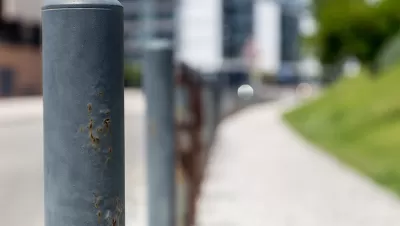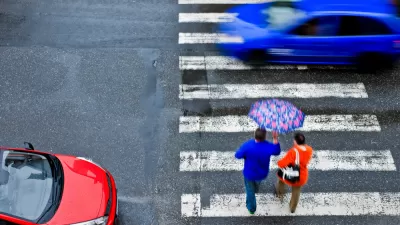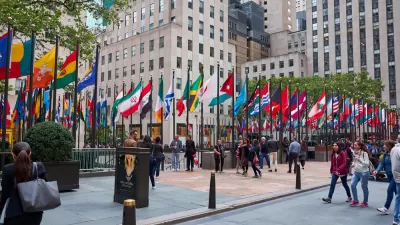Countless lives were likely saved by a strategically placed bollard on W. 45th Ave. which stopped a motorist who had driven three blocks on city sidewalks, mowing-down as many pedestrians as possible, from entering the Times Square pedestrian plaza.

On May 18, Bronx resident Richard Rojas, a 26-year-old Navy veteran high on PCP, made a sudden U-turn on Seventh Avenue and W. 42nd St., driving onto the sidewalk and where he proceeded unimpeded to strike 23 pedestrians on three blocks of the Seventh Avenue sidewalk. One of them, Alyssa Elsman, 18, who was visiting New York City from Michigan, died of her injuries.
Although the incident was determined not to be the act of a terrorist, it was the threat of terrorism that was responsible for the bollards being placed at the entrance to the pedestrian plaza, recounts Benjamin Mueller for The New York Times.
Planners describe it as a turning point in the redesign of Times Square: a meeting around the end of 2012 when David C. Kelly, then the Police Department’s assistant commissioner for counterterrorism, showed up with a copy of Al Qaeda’s English-language magazine, which called on attackers to "mow down” pedestrians with pickup trucks.
Soon, at Mr. Kelly’s recommendation, pedestrian plazas that had replaced roadway along a five-block stretch of Broadway were guarded by three-foot-tall, stainless-steel cylindrical bollards.
In an op-ed published in the Daily News (posted here) on the Times Square rampage, Paul Steely White, executive director of New York City-based Transportation Alternatives, wrote:
To prevent further loss of life, in the wake of yesterday’s tragedy we must realize that it was the controversial street safety improvements applied to Times Square in recent years — including wider sidewalks protected with steel and concrete bollards — that prevented the tragedy from being far worse.
Burney describes the planning process that was responsible for the installation of the bollards, and why more weren't placed around the area during the redesign that officially opened April 19 after work first began in May 2009.
“We found the right balance between the type of potential threat and the idea of creating a porous and fluid public realm,” said Craig Dykers, founding partner of Snøhetta, the architectural firm on the project,
While the threat from terrorists is real, as was tragically shown in Nice, France at a Bastille Day celebration last year when a terrorist drove a truck into a crowd, killing 85 and injuring over 200, so too is the threat from motorists like Rojas, who has a criminal record and a history of drunken driving and mental illness.
More bollards recommended
"The city is considering adding bollards on sidewalks around Times Square to match those around pedestrian plazas, the Police Department’s deputy commissioner for intelligence and counterterrorism, John J. Miller, told the City Council on [May 23]," adds Mueller.
Ydanis Rodriguez, a city councilman who is the chairman of the transportation committee, said he began drafting legislation several months ago to ask that bollards be installed outside schools and on busy corners across the city.
"We can and should do more to keep our residents and visitors safe on our streets and street design is the first place to start," said Rodriguez,
"It is likely that the next pedestrian death will not occur under the worldwide lens of Times Square, but on a regular street in a regular New York City neighborhood," adds White.
FULL STORY: In Times Square Attack, Bollards Stopped One Car. But What About the Next?

Alabama: Trump Terminates Settlements for Black Communities Harmed By Raw Sewage
Trump deemed the landmark civil rights agreement “illegal DEI and environmental justice policy.”

Planetizen Federal Action Tracker
A weekly monitor of how Trump’s orders and actions are impacting planners and planning in America.

Why Should We Subsidize Public Transportation?
Many public transit agencies face financial stress due to rising costs, declining fare revenue, and declining subsidies. Transit advocates must provide a strong business case for increasing public transit funding.

Understanding Road Diets
An explainer from Momentum highlights the advantages of reducing vehicle lanes in favor of more bike, transit, and pedestrian infrastructure.

New California Law Regulates Warehouse Pollution
A new law tightens building and emissions regulations for large distribution warehouses to mitigate air pollution and traffic in surrounding communities.

Phoenix Announces Opening Date for Light Rail Extension
The South Central extension will connect South Phoenix to downtown and other major hubs starting on June 7.
Urban Design for Planners 1: Software Tools
This six-course series explores essential urban design concepts using open source software and equips planners with the tools they need to participate fully in the urban design process.
Planning for Universal Design
Learn the tools for implementing Universal Design in planning regulations.
Caltrans
Smith Gee Studio
Institute for Housing and Urban Development Studies (IHS)
City of Grandview
Harvard GSD Executive Education
Toledo-Lucas County Plan Commissions
Salt Lake City
NYU Wagner Graduate School of Public Service




























